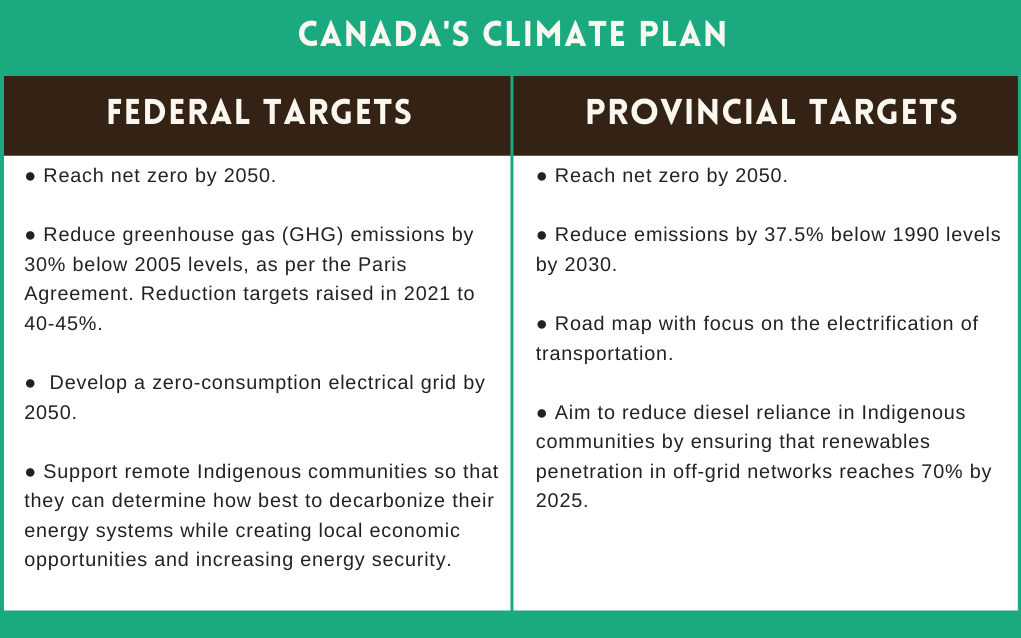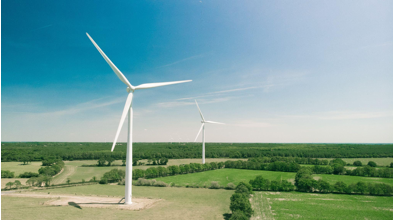This pan-Canadian series of interviews with experts in their field provides an overview of renewable energy deployment across Canada and the measures being implemented to become carbon neutral.
Here is the first in the series, a discussion on the energy transition in Quebec and the circular economy with Johanne Whitmore, Senior Researcher at the Energy Sector Management Chair at HEC Montreal. Let’s start with the targets set by the federal and Quebec governments to reduce greenhouse gas emissions.
First, let’s recall the targets set by the federal and Ontario governments for the reduction of greenhouse gas emissions.

Reference : Pembina report 2021 All hands on deck
Nergica : What kind of research do you do at HEC Montréal’s Chair in Energy Sector Management?
Johanne Whitmore : Founded in 2013, the Chair represents the first time that issues related to sustainable management in the energy sector are being studied in a management school. The Chair aims to develop expertise in energy-related issues from the perspective of sustainable development, optimization and a balance between energy sources and the needs of society.
 My research mainly consists of evaluating the effectiveness of energy and climate policies to reach GHG emission reduction targets, as well as assessing strategies that favour a circular economy. Our expertise has led us to contribute to a number of committees including Innovation industrielle (Investissement Québec), Fonds d’économie circulaire (Fondaction) and Énergie et environnement (FCCQ). I am also a member of the Centre for Interuniversity Research and Analysis of Organizations (CIRANO).
My research mainly consists of evaluating the effectiveness of energy and climate policies to reach GHG emission reduction targets, as well as assessing strategies that favour a circular economy. Our expertise has led us to contribute to a number of committees including Innovation industrielle (Investissement Québec), Fonds d’économie circulaire (Fondaction) and Énergie et environnement (FCCQ). I am also a member of the Centre for Interuniversity Research and Analysis of Organizations (CIRANO).
Nergica : Can you give us some examples of the types of projects that you are currently working on?
JW : The Chair contributes to the public debate through the publication of data and objective analyses in order to stimulate constructive exchanges between stakeholders. For example, every year we publish the État de l’énergie au Québec, a summary of the latest and most relevant data on Quebec’s energy sector. We also organize, in collaboration with the MERN, workshops on various issues in order to spark a discussion on how we can accelerate the energy transition and decarbonation in Quebec. Our most recent workshops were dedicated to environmental taxation and energy regulation as well as energy data accessibility and transparency.
These are important issues for the renewable energy sector. Outdated regulations or a lack of data or communication represent an obstacle to the energy transition. With the prices of conventional energy often being low, it will be essential to rethink how the energy sectors are taxed and regulated in order to accelerate the deployment of renewables on the market and ensure the profitability of Quebec’s renewable energy industry.
We are also concerned with the accessibility and transparency of energy data. In Canada, data are often incomplete at the provincial level. This gap means that it is difficult for industries, governments and researchers to get a comprehensive overview of the markets and to develop cost-effective solutions to accelerate the energy transition in Quebec.
Nergica : In your opinion, are Quebec’s environmental goals and how it will achieve them clear?
JW : The GHG reduction target for 2030 is clear: 37.5% below 1990 levels. In its 2030 Energy Policy, the government has five clearly-defined targets, including a 40% reduction of petroleum-based products, a 25% increase in the total production of renewable energy and a 50% increase in bioenergy compared to 2013.
What is less clear is the 2050 target announced in the Plan for a Green Economy. This target aims to achieve “carbon neutrality,” which means reducing GHG emissions to zero or offsetting those that cannot be eliminated. The government has not indicated how it will define or count emission reduction offsets in its GHG inventory so as to avoid double counting reductions or, worse yet, no reductions at all. The government will therefore first have to define these reductions and establish standardized protocols for emission offsets.
Nergica : What are the main challenges that Quebec currently faces as it attempts to undertake its energy transition?

JW : The greatest challenge is inertia. Quebec’s energy profile is largely carbon-free compared to other regions thanks to its significant hydro resources, which can lead its citizens to think that they have already done their part in the fight against climate change. The reality, however, is that we consume more energy per capita than other regions, including the United States (i.e. 224 GJ/person vs. 201 GJ/person in 2018)! Our consumption of petroleum-based products, mainly for transportation, has increased by 5% since 1995. Additionally, our GHG emissions have been stagnating since 2010. We therefore have a long way to go to reach our targets.
When Quebec developed its hydro resources in the 1960s, it was because they were abundant and not because they were clean. By ensuring greater energy independence and security, the Quebec government encouraged economic development in the province. Today, these circumstances give us a head start over our neighbours in combating climate change.
Quebec therefore has the responsibility to capitalize on this advantage and demonstrate leadership in the energy transition. If Quebec is incapable of achieving this transition despite its ample, affordable energy, it will be difficult to imagine how other regions can be expected to succeed! This is an opportunity to be seized to make Quebec a living lab to develop business models and innovative technologies, deploy pilot projects, and develop new approaches to management and energy efficiency to ensure that innovations are cost-efficient.
Nergica : Since electricity in Quebec has been “green” for so long and there is significant emphasis here on innovation, what is limiting the build-out of more wind and solar projects in the province?
JW : One of the challenges is the lack of cost efficiency and transparency in Quebec’s electricity market. This represents a barrier to competition and innovation due to electricity rates that are controlled by Quebec’s energy board, the Régie de l’énergie (which may be influenced by political interests). How the Régie takes environmental and energy transition factors into account in its decision-making can also be arbitrary. This situation is the opposite that of New York state, which has adopted a major reform to restructure its electricity market, and as a result now enjoys new production opportunities that are less costly, more environmentally friendly and where there is greater competition and more choices for the consumer.
To spur innovation, the Quebec government also relies more heavily on incentives such as the Roulez vert program for the purchase of electric vehicles. However, in order to transform our markets and promote renewables, we will have to use other tools such as tax mechanisms, regulatory reforms and communication campaigns.
Nergica : In other words, it is not a technological or resource issue, but rather a political issue?

JW : Indeed, we need to stop “politicizing” the Electrification and Climate Change Fund (FECC; formerly the Green Fund) so that it is independent of the cabinets of ministers and its management is more transparent. Bill 44 comes up far short of meeting these two basic criteria. An inspiring model is that of the UK government, which passed a law to create an independent Committee on Climate Change (UK CCC). This committee has a clear mandate and receives annual dedicated funding to avoid any political interference in the fight against climate change. The committee evaluates the government’s action plans, publishes recommendations and analyses, and carries out follow-ups of the measures implemented by each ministry to ensure that overall objectives are being reached.
Nergica : Quebec thus has a long way to go in its energy transition even though hydro power has made up the lion’s share of the energy mix for decades already. According to the État de l’énergie au Québec report published by your Chair in January 2021, 94% of the electricity generated in the province in 2019 was from hydro resources, 5% from wind, and less than 1% from biomass and diesel. In this context, would it not be difficult to achieve significant GHG reductions, i.e. 37.5% by 2030, as is currently being targeted by the government?
JW : Solving our climate crisis will depend more on how we consume energy than where this energy comes from. Access to ever more efficient energy sources has enabled humanity to accelerate the transformation of resources into goods while fostering a global economic expansion. From biomass, we switched to coal in the 18th century and then to oil and natural gas in the 20th century. Hydrocarbons currently supply 90% of humanity’s energy needs. The transition that scientists are urging us to undertake aims to avert environmental catastrophe by replacing efficient energy sources (hydrocarbons) by sources that are often less efficient (renewables). This would mean reversing an historical trend.
As hydrocarbons are currently the main energy source for humanity, replacing them by less efficient and oftentimes more costly sources will be impossible without radically changing our consumer habits. To achieve this, we need to first focus on reducing our total energy consumption. Only then can we offset GHGs or minimize what remains of our hydrocarbon consumption by shifting to lower-emitting – albeit more costly in certain cases and with inferior energy yields compared to oil – energy sources (e.g. biofuels, solar, wind, green hydrogen).
The energy transition is first and foremost about smarter consumer habits. This is a point that I emphasize in a chapter of the book Les trentes idées reçues du développement durable (in French only).

The good news is that we have the means to match our ambitions: in the history of humanity, never before has there been so much wealth and energy surplus as we have today. We just have to use our imagination to build an economy different than the one we have known for so long.
Nergica : One of the things presented in your report is energy losses in Quebec and the fact that the province’s average per capita energy consumption is higher than that of the U.S. When you listen to what is being said in various social, political and economic circles in Quebec, we seem to pride ourselves on being better champions of the environment than our neighbours. How would you explain this situation?
JW : Generally speaking, the less electricity costs, the more we consume. This is certainly the case in Quebec, which explains why we rank so poorly in terms of per capita energy consumption. However, cheap and plentiful electricity has also made it possible to attract major industries that have contributed to Quebec’s economic development such as the aluminum, cement and steel sectors. In fact, the greatest energy losses are found in the transportation sector (both passenger and freight) due to vehicle inefficiencies. Certain industrial sectors also exhibit significant energy losses, but competition and social pressure are driving them to improve their performance. However, one challenge for this sector is that a significant portion of emissions stems not from energy consumption but rather from industrial processes.
 It must also be noted that being part of a renewable energy sector (as a producer, supplier, distributor, manufacturer, etc.) doesn’t automatically earn a company “ecofriendly” status. It is important for businesses in this sector to take into consideration the impact of their product or service on the entire value chain. In Quebec, a number of government and private resources are now available to support businesses in their circular economy strategies. This approach ensures not only better environmental performance, but also superior economic performance through productivity gains.
It must also be noted that being part of a renewable energy sector (as a producer, supplier, distributor, manufacturer, etc.) doesn’t automatically earn a company “ecofriendly” status. It is important for businesses in this sector to take into consideration the impact of their product or service on the entire value chain. In Quebec, a number of government and private resources are now available to support businesses in their circular economy strategies. This approach ensures not only better environmental performance, but also superior economic performance through productivity gains.
Nergica : We often hear Quebec-based companies emphasize that their carbon footprint is smaller than that of their competitors since electricity in the province is renewable. It’s better than nothing, I suppose…
JW : Ultimately, businesses must strive to shift to a business model based on circular economy strategies. The linear model whereby we extract, produce, consume and throw away has become so inefficient that it is now more costly for society and businesses to maintain. It is possible to simultaneously improve both economic and environmental performance if we rethink our business models to optimize and improve energy and resource productivity across the value chain in order to maximize production for each unit of energy produced or each unit of GHG emitted by a company. By including circularity indicators in their performance reports and decision-making, corporate management teams can coordinate their economic performance with their environmental performance.
Nergica : One recurring element that sticks out in my mind is that we need to be more proactive! In addition to consuming less, we need more data for better forecasting, more upstream analyses, and we need to think about recycling before we start manufacturing, and not just when our backs are against the wall, etc.
JW : Indeed, in Quebec a large number of wind turbines will eventually reach the end of their useful life of around 25 years. If we can recover these components or other infrastructure elements, it’s beneficial from both an environmental and an economic point of view. Batteries for electric vehicles are another good example. Quebec is investing in the development of this technology and is attempting to position itself as a leader in the field. This will help reduce transportation-related GHG emissions as well as create jobs. However, from the get-go, there need to be circularity standards and criteria for mining the raw materials while minimizing the impact throughout the value chain of these products.
This interview was conducted as part of a series of regional portraits of renewable energy in Canada. To hear the opinions of other energy transition experts and players, join us at the Transition Solutions Symposium on October 14, 2021, a pan-Canadian event dedicated to the technological, social and political innovations needed to deploy renewable energy and accelerate the energy transition in Canada.
Other publications in this series:
Dr. Michael Ross, Industrial Research Chair in Northern Energy Innovation at Yukon College
Brandy Giannetta, Vice-President, Policy, Regulatory and Government Affairs at CanREA
More to come soon!


